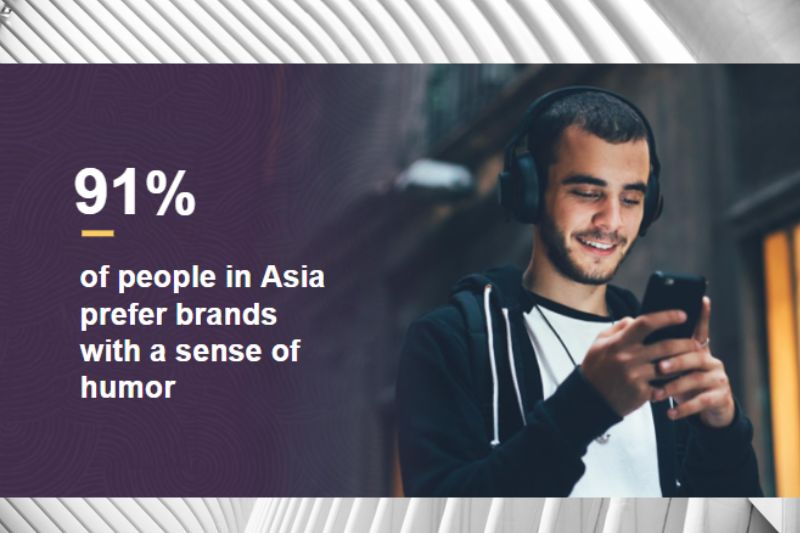KUALA LUMPUR, MALAYSIA – June 16, 2022 – People want brands to make them smile and laugh, yet business leaders fear using humor in customer interactions according to the Happiness Report from Oracle and Gretchen Rubin, five-time New York Times bestselling author and podcaster. The research report that includes insights from more than 12,000 people across 14 countries, including over 5,000 from Asia Pacific (APAC), found that people are searching for new experiences to make them smile and laugh and will reward brands that embrace humor with loyalty, advocacy, and repeat purchases, and walk away from those that don’t.
People in APAC are searching for happiness in new ways and are willing to pay a premium
It has been more than two years since many people last felt true happiness and they are searching for ways to be happy again, no matter the cost. Here are some findings from APAC respondents.
- 44 percent of APAC respondents said they have not felt true happiness for more than two years and 25 percent don’t know, or have forgotten, what it means to feel truly happy.
- 85 percent are looking for new experiences to make them smile and laugh. People in APAC are prioritizing health (78 percent), personal connections (77 percent), and experiences (45 percent) to gain happiness.
- To feel just an hour of true happiness, many people would give up friends (62 percent), part of their income (61 percent), and showering (55 percent) for a week.
- More than half of APAC respondents (56 percent) wish money could buy happiness, with 81 percent willing to pay a premium for true happiness.
- 89 percent attempted to find happiness in online shopping during the pandemic and while 47 percent said that receiving packages made them happy.
Advertising, marketing, sales, and customer service interactions need to change
People want brands to make them smile and laugh, but business leaders are scared of using humor in customer interactions for fear of being canceled.
- 76 percent of people believe brands can do more to deliver happiness to their customers and 91 percent said they preferred brands to be funny; this number increased among Gen Z (95 percent) and Millennials (95 percent)
- Advertising: 89 percent are more likely to remember ads that are funny, yet business leaders in Asia Pacific said that only 17 percent of their brands’ offline ads (TV, billboards) and 14 percent of their online ads actively use humor.
- Social channels: 74 percent of people would follow a brand if it’s funny on its social media channels, yet only 12 percent of business leaders said their brand is humorous on social.
- Email marketing: 68 percent of people would open an email from a brand if the subject line were funnier, yet only 21 percent of business leaders in APAC said they actively use humor in email marketing campaigns.
- Chatbots/digital assistants: 67 percent would prefer to engage with a chatbot/digital assistant that is funny, yet only 24 percent of business leaders in APAC said their brands actively incorporate humor into bot communications.
Smiles and laughter pay dividends, but business leaders are afraid to joke around
People will reward brands that embrace humor with loyalty, advocacy, and repeat purchases and will walk away from those that don’t.
- 56 percent of people don’t believe they have a relationship with a brand unless it makes them smile or laugh and 49 percent would walk away from a brand if it didn’t make them laugh or smile regularly.
- If a brand uses humor, people are more likely to buy from the brand again (82 percent), recommend the brand to family and friends (81 percent), choose the brand over the competition (76 percent), and spend more with a brand (67 percent).
- 90 percent of business leaders see the opportunity to use humor to enhance the customer experience and believe that their brand can do more to make customers laugh or smile.
- 76 percent of business leaders fear using humor in customer interactions.
- 87 percent of business leaders state that they do not have the data insights or tools to successfully deliver humor. Business leaders would be more confident using humor when engaging with customers if they had better customer visibility (54 percent) and access to advanced technologies like artificial intelligence (37 percent).
“We’ve all been through some very tough years, and happiness around the world is lacking. We’re starved for experiences that make us laugh and smile, but brands can help,” said Gretchen Rubin, five-time New York Times bestseller author and podcaster. “For brands looking to contribute to the happiness of their target audience, it starts with data and knowing your customers. Only then, can you bring the appropriate mix of humor, personality and brand experience that will drive loyalty and brand advocacy.”
“With people being ready to embrace the funny side of life, the role of brands for consumers has evolved,” said Fitri Abdullah, Managing Director, Oracle Malaysia. “As our research shows, most business leaders are seeing the value of establishing relationships with happier customers. By leveraging data analytics, brands are better equipped to get humour right and pave the way for higher brand loyalty.”
Learn more about this global report here.










